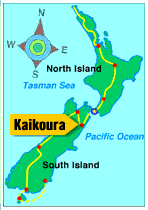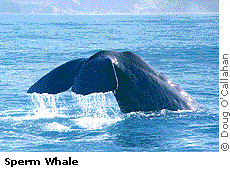New Zealand Home
 |
Sea Life at Kaikoura |
 |
|
 More than 200 species of marine life can be found off the coast of Kaikoura. Plus, Kaikoura is one of the best places in the world to see fur seals, sperm whales, and dolphins. It is the only place in the world where sperm whales feed close to shore!
More than 200 species of marine life can be found off the coast of Kaikoura. Plus, Kaikoura is one of the best places in the world to see fur seals, sperm whales, and dolphins. It is the only place in the world where sperm whales feed close to shore!
What makes Kaikoura such an excellent place for sea life? First, remember that New Zealand is positioned at the eastern edge of the Indo-Australian continental shelf. Just out to sea from Kaikoura, the continental shelf slopes gradually to a depth of 100 meters, then plunges to a depth of almost 1,000 meters. Warm and cold currents converge here and a southerly current is constantly striking the continental shelf. These conditions cause nutrients to rise up from the seafloor. When these nutrients reach a depth where light can penetrate, they become useful for plant life that live in the sea. The plants feed small marine animals, who, in turn, are food for large marine mammals.
Ask the Expert Want to learn more about marine mammals like whales and seals? Explore these Web sites for facts, photos, and more! Seal and whale photos: ©Doug O'Callahan, Kodak Express, West End, Kaikoura, New Zealand |
|||
|
|||
 As a biologist, Colin is interested in the diversity of sea life. But he's also interested in undersea creatures because they do not evolve and change as much as land animals. You see, the environment on land can be a hostile place, with harsh sunlight, floods, fire, and extreme temperatures. The environment beneath the sea doesn't undergo nearly as many changes, so conditions in the sea remain constant for long periods of time.
As a biologist, Colin is interested in the diversity of sea life. But he's also interested in undersea creatures because they do not evolve and change as much as land animals. You see, the environment on land can be a hostile place, with harsh sunlight, floods, fire, and extreme temperatures. The environment beneath the sea doesn't undergo nearly as many changes, so conditions in the sea remain constant for long periods of time.